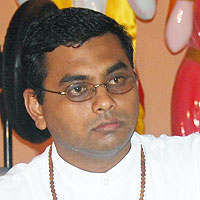Wwe look at providing a strong Hindu environment for our children. We are all familiar with the old adage, “You can’t straighten a crooked tree.” With this in mind, it is crucial that parents educate their children about Hinduism from a tender age. There are two extremely important reasons for this: Firstly, psychologists are of the view that children learn and retain the most from the ages two-five. Therefore, we parents who subscribe to the view that “the chirren too small yet; leh them play”, must now change our thinking.
Early speech of young children should include the words, ‘Om’, ‘Sitaram’, ‘Shanti’, as well as simple ‘kirtans’ and ‘mantras’. We can also inculcate in them actions like rising early, offering ‘jal’, bowing to the feet of God and parents. Taking them to the temple is a must because this is the place where they can engage in Hindu activities, especially if little of this is being done at home. Children may start off playfully shouting ‘mantras’ and ‘bhajans’, but soon enough their practices will blossom into serious meaningful living. I will share two examples that I find beautiful that describes actions of two children under six years. On the occasion of the birthday of one of them, the mother asked, “Do you want to go for pizza or to the movies?” The child responded, “I want to do a ‘pooja’.” The second child gets up earlier than the adults, races to the yard to get her share of flowers to offer to God, even if it involves leaving none of the limited supply for the rest of the family. I remember Shankaracharya saying that if we are greedy, we should be greedy for God’s blessings. This little child is already following this principle, without even hearing such advice
Secondly, there are five aspects of ourselves or who we are. Three of these are: physical self, social self and ideal self. Our physical self is not only our body but also includes a picture of ourselves we carry in our mind called our ‘body image’. Parents can strongly influence their children’s body image to reflect that of a Hindu simply by dressing their young in Hindu attire for appropriate functions and making them proud to sport their ‘raksha’, ‘sindoor’, ‘bindi’ and so forth. Constant and sustained reinforcement of a Hindu ‘look’ will help our children to get a positive physical reflection of themselves and to also mentally perceive their physical appearance in a positive way.
Body image helps our children to develop their identity. Identity gives us our place in the community, the society, the world. Projecting a Hindu physical identity for our children might be a deterrent to the many culture ‘bandits’ out there who may just realise, “I won’t get through with this one so easily.” If we as parents help our children to develop a positive Hindu body image, we will be saving them from the unpleasantness of the identity crisis that so many of our Hindu youth today are experiencing.
By Mrs. Mala Persad


